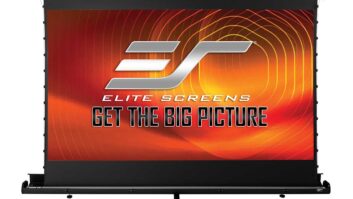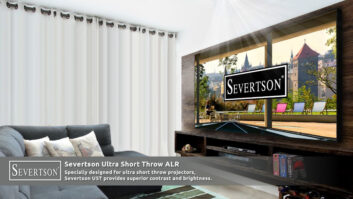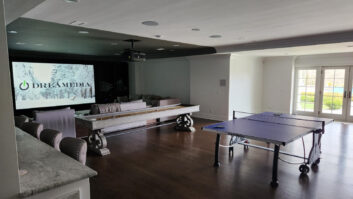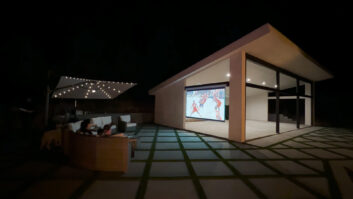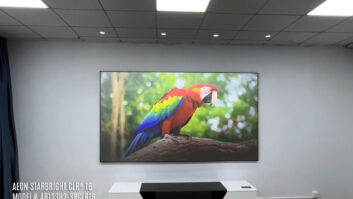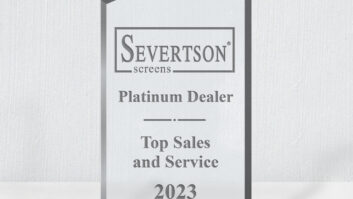
Stewart’s current home cinema offering is the Director’s Choice 100, featuring a precise horizontal masking system that closes completely, keeping dust and debris away from the screen when it’s not in use. Luring consumers away from uber cheap, margin sucking flat-panels isn’t all that hard today. As inexpensive as flat-panels can be, when it comes to the larger sizes and ultra HD options like 4K, projection systems are the way to go.
Of late, the major trends affecting the projection screens market have remained relatively constant, yet manufacturers are still busily adapting their product lines to maximize efficiency, versatility, costs, and of course, image quality. While touting current offerings on the one hand, screen manufacturers are also prepping for big CEDIA introductions this September.
By and large, the overriding consumer trend that continues to drive projection screen development is the dominance of multi-purpose entertainment spaces over dedicated home theaters. This inclination has turned out to be a boon for projection systems because they’re open to a wider pool of applications, and it has forced manufacturers to develop versatile ambient light solutions.
“The holy grail of a projection screen experience is a surface that has the brightness and clarity of an LCD flat-panel in regular household lighting levels,” stated David Rodgers, marketing manager, Elite Screens.

Draper specifically developed its High Performance XS850E screen material to address ambient lighting conditions. The Elite Prime Vision (EPV) product line consists of a series of ambient light-rejecting screens to be highlighted at CEDIA in Denver. The Dark Star black projection screen uses a retro-reflective ambient light rejecting design and serves as Elite’s premier quality product, providing integrators more upsell potential. In a nod to 3D technology, Elite offers the EPV Airbright 5D angular reflective material that rejects ambient light, yet it is polarized for optimal 3D viewing.
Draper specifically developed its XS850E screen material to address ambient lighting conditions. “It gives you a nice bright image and excellent contrast in the dark or under ambient light,” said Bob Hadsell, home theater sales manager for Draper. “What sets it apart from similar products, though, is that you see the same great image off axis. It has a 180-degree viewing cone.”
Stewart Filmscreen has observed a continuous growth in the multi-functional environment, noting the specific challenges the presence of ambient light presents. In addressing ambient light, Stewart’s director of marketing Dave McFarland conceded that “while compromise is necessary, Stewart uniquely understand that the end result must still be the ‘wow’ that is associated with an immersive, visually stunning, in-home cinema experience. With this in mind, Stewart is pushing the envelope on innovative solutions and will be showcasing our latest breakthrough product at CEDIA 2013 in Denver.”
This includes an all-in-one blackout shade, projection screen, and vertical masking system. “Designed to be mounted in front of windows or glass doors, this electric roll-down screen system is ideal for transforming bedrooms and other multi-functional entertainment spaces into a high performance home theater,” McFarland said. Stewart will also demo various other products for dedicated home theaters, as well as for outdoor entertainment.

The recent evolution of Vutec’s SilverStar surface also included modifications enhancing picture resolution and definition, as well as a multi-panel version for large commercial applications. Stewart’s current home cinema offering is the Director’s Choice 100, featuring a precise horizontal masking system that closes completely, keeping dust and debris away from the screen when it’s not in use. The DC-100 has a 10-inch frame profile and 10 inches of depth.
“This slimmer profile allows for the maximum possible screen area within a given room dimension, and the variable masking ensures that any and all content, regardless of aspect ratio or resolution is appropriately sized and framed in deep black, enhancing contrast and producing the best possible viewing experience,” McFarland said.
The demand for wall-to-wall screens is one market force that John Caldwell, president of Grace Motif, has observed, which, along with aesthetic considerations from designers, necessitates acoustically transparent screens. Grace Motif’s Vevo Acoustic 3D answers the call as an acoustically transparent, polarized, woven screen material.
“The change from 1080 to 4K is also driving new screen considerations,” Caldwell noted, as is 3D, which he said, “while not widely adopted, remains a market segment.”

The Grommesh house in Moorhead, MN, featured on ABC’s “Extreme Makeover: Home Edition,” highlights Elite Screen’s 100-inch fixed-frame projection screen. Some of Grace Motif’s other current offerings include the IMAGE-Screens NivoNova surface, for vibrant color in ambient light conditions; and the Vevo Acoustic, 2K-ready material available in white, grey, and black, as well as a 4K version. Grace Motif’s frame-fixing system plus snap button surface fix makes installation simpler. Various frame sizes and custom design selections include a zero-edge option.
Da-Lite’s latest screen developments are also driven by the introduction of 4K technology for the residential market. “The recent expansion of our HD Progressive surfaces to include a 1.3 gain means that we have a solution for high definition projection in any environment,” said Melissa Rone, senior marketing manager, Da-Lite.
The HD Progressive 0.6, 0.9, 1.1, and 1.3 were all designed for 4K application. Other recent products from Da-Lite include the UTB Contour, featuring thin bezel frames, in addition to 4K optimization.
Demand for acoustically transparent, luxury screens are “Seymour-Screen Excellence’s specialty,” according to Paul Muto, SSE director of sales and marketing, “and it’s been steadily growing the company since our market launch in 2010.”
SSE is commonly fulfilling orders ranging from higher-end fixed screens with motorized masking systems, as well as retractable motorized screens with dual masking systems, to more moderately priced fixed frame designs with removable magnetic masking panels, Muto noted.
The motorized screen trend is well represented among various manufacturers, including Vutec, with its SilverStar offering, which was recently upgraded with a roll-up model for more convenient logistics, which will lead to a motorized version, according to Craig Waldman, director, marketing and communications, Vutec. The recent evolution of the SilverStar surface also included modifications enhancing picture resolution and definition, as well as a multi-panel version for large commercial applications. High contrast and brightness in ambient light conditions are also characteristics of the SilverStar material.
Screen Innovations’ Black Diamond Motorized screen is now shipping. The material rejects light from the top, bottom, left, or right, according to Blake Vackar, SI director of sales. “It can even handle light hitting it from behind because it’s 100 percent opaque… Plus, homeowners love it because it solves many TV placement issues; it can go above or over fireplaces, in windows, doorways, and other areas that require a TV that will disappear when not in use.”
SI has also recently released the Pure White Zero Edge and Pure Gray Zero Edge screens, featuring micro texture nine times finer and smoother than other materials.
Elite Screen’s Rodgers noted that the current state of the economy and fierce competition between manufacturers has forever changed the landscape of home theater manufacturing. Yet, he still believes that two factors are working in the integrator’s favor.
“First, although customer budgets have gotten tighter, overall product quality has gotten better, and brand competition has led to prices being lower than ever before,” he said. “Secondly, this is an opportunity to expand the market into demographics that previously could not afford to join the home theater club.”
Lindsey Adler is associate editor of Residential Systems, Systems Contractor News, and Healthcare AV.
